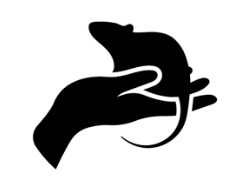Rodent Book Club - Mice as Pets, by Mervin F. Roberts, 1977
Hoo boy, strap yourselves in for a laugh and a cry because this book has not aged well.
What was once a current representation of mouse keeping written by a mouse lover has aged into a cringe-worthy compilation of bad advice. Care guides for rats and mice can tell us a lot about the standard of welfare and attitudes over time, and should serve as a reminder that knowledge is NOT absolute - we should be learning and improving all the time!
If I had a dollar for every person who has come to the rescue wanting to adopt a lone rat for their children, with fond memories of their single childhood rat. The conversation is always along the lines of “Hey, back then we thought keeping lone rats was fine and I’m really happy for your awesome memories! But now we know a lot more about rat care, so here’s why that’s bad for them, and here’s how we’re going to do better this time.”
But back to the book. It’s not long, of the 32 pages about half of the space is photographs, and the text gives a crash course in what mice are, how to set up an enclosure, handle, feed and breed them, and a bit about the ideas of showing and genetics. As expected from a book that sums up “Keeping your mice healthy” in half a page of large print text, the information isn’t terribly detailed, but it’s clear from the writing that the author did genuinely have a love and passion for mice. Keep that in mind, because some of the advice is… not super.
By page four I was already laughing, as Roberts asserts that “mice have no odor” - as someone who currently has 180 rescue rats and five male rescue mice, guess which smells worse? A male mouse is a bioweapon as far as I’m concerned. Straightaway it advises to get a few mice from a pet store, plus an extra cage “which nature will soon provide the need for.” No mouse fancier today is so nonchalant about breeding mice for fun at home, but we’re reading of a time when breeding mice at home might be given as a science project, the ethics just hadn’t caught up yet and mice were still more or less disposable, an attitude that hasn’t quite been shaken even today.
The housing advice is to get a small fish tank, add wire on top, and provide a layer of sawdust, a ball of cotton fluff in the corner, a bowl of water, and some seeds. The difference between “surviving” and “thriving” is pretty obvious in rescues I take in from these still-common setups, even something as simple as having nowhere to hide has a profound effect on stress and by extension, health.
Some other absolute club bangers from our boy Roberts include:
“The best way to pick up your mouse is to grasp it firmly at the middle of the tail” (the base is more appropriate),
“In a pinch you can keep one or two mice in a one gallon wide mouth pickle jar” (Martin, no)
“Hay makes up an important part of a mouse’s diet” (you’re thinking of guinea pigs) and
“Mice make wonderful pets and only ‘sissies’ are afraid of them!” (I always find shaming adopters with toxic masculinity to be the most effective sales pitch)
Honestly, I could keep going, but in the context of when it was written, it doesn’t actually do so bad. Full page pictures of female versus male genitals like in the book are something I think every pet shop should staple to the forehead of all employees and give to all buyers.
Even advice that seems abhorrent to us now sort of makes sense for the time, like “If you have sick or half-sick mice, destroy them. Do it promptly.” The 70’s were 50 years ago. It’s hard NOW to get a vet who can treat mice, imagine that world with no internet, no community boards of fanciers to recommend a vet over in the next town or suburb. A vet couldn’t just look up papers during a consult to even have a good crack at treatment. Without proper vet treatment available to most owners, probably was the best thing to do, to euthanize a mouse that had begun suffering.
So what CAN we learn from this book, does it have any value in the modern day? I would say yes, but only as a point of historical reference for the changes in general advice among the fancy over time. The danger lies in the modern interpretation, no part of it is worthwhile advice for the modern mouse owner.
One sentence summary: Mouse care in the 1970’s was very different to what we know now, even though the author clearly loved mice, his words haven’t aged well.
Worth a read if: You already know a lot about mice and are interested in the old school fancy, perhaps old definitions of type and conformation.
By Grover Greenfield
-
Want to recommend a book or other piece of media for me to review? Have some cool old rodent-related paraphernalia you’d like to show us? Want to discuss content or just say hi?
Flick us an email, we’d love to hear from you!


